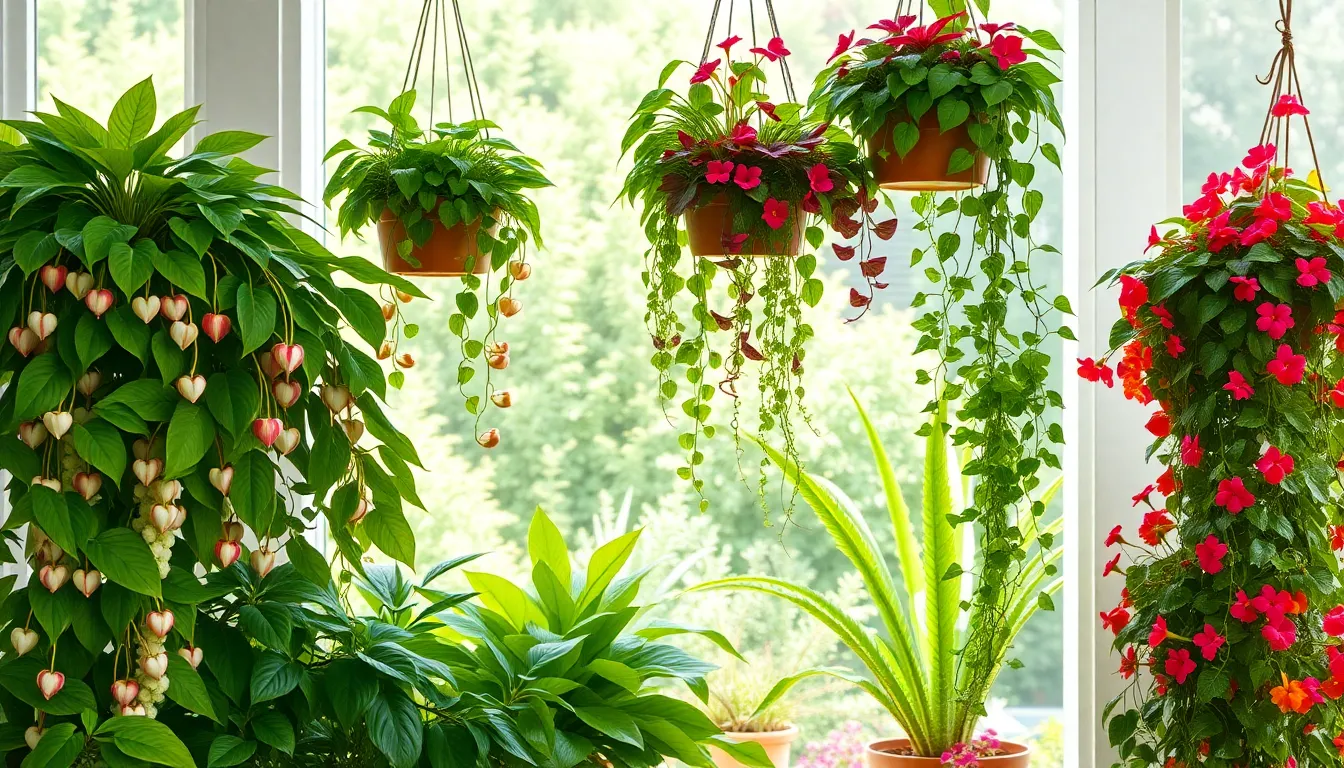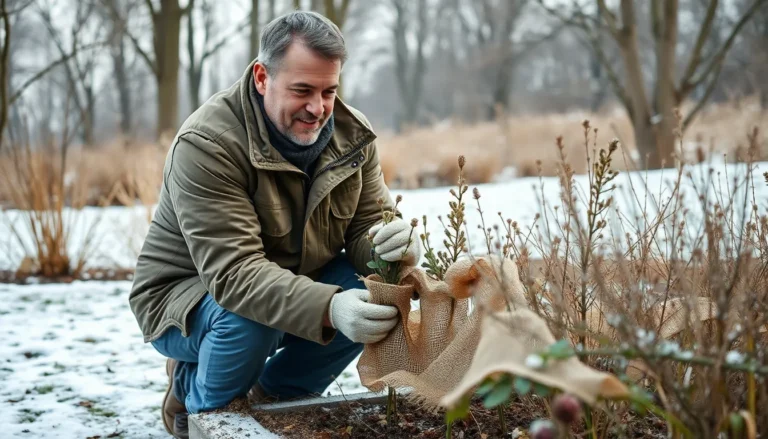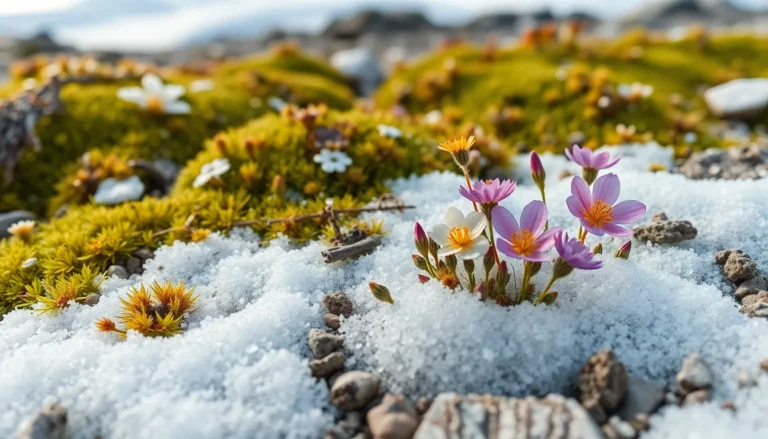
Cascading Plants: Transform Your Space with Vibrant Beauty and Easy Care Tips
Cascading plants are like the rock stars of the gardening world, stealing the spotlight with their dramatic drapes and vibrant foliage. Imagine walking into a room where lush greenery spills over the edges of pots, creating an enchanting waterfall of leaves. These plants don’t just add beauty; they bring a sense of tranquility that’s hard to resist.
Cascading Plants
Cascading plants thrive in various environments, making them ideal choices for gardens and indoor spaces. These greenery types, known for their elongated stems and dramatic growth, often spill gracefully from hanging baskets or containers. They add depth and texture to landscape designs while creating stunning visual effects.
Many popular varieties include pothos, trailing geraniums, and string of hearts. Pothos plants excel in low-light settings and adapt well to different conditions. Trailing geraniums provide vibrant colors throughout the growing season, enhancing outdoor patios and balconies. String of hearts captivates with its unique heart-shaped leaves, appealing particularly to succulent enthusiasts.
When selecting cascading plants, consider light requirements and overall space. Shade-tolerant options work well in dimly lit areas, whereas sun-loving varieties require ample sunlight for optimal growth. Watering needs also vary; some prefer consistent moisture, while others thrive with occasional drought.
Maintenance involves pruning to encourage healthy growth and deadheading spent flowers for prolonged blooming. Regularly checking for pests ensures that these plants remain healthy and vibrant. Fertilizing during the growing season supports robust development and lush foliage.
Cascading plants’ versatility extends beyond aesthetics, contributing to improved air quality indoors. They release oxygen while absorbing carbon dioxide, enhancing overall well-being. These plants transform spaces, inviting tranquility and beauty into everyday life.
Types of Cascading Plants

Cascading plants come in various forms, each adding its unique charm to gardens and interiors. Understanding the types helps in making informed choices for specific environments.
Indoor Cascading Plants
Pothos thrives indoors with its heart-shaped leaves, flourishing in low light. String of hearts offers delicate, trailing vines adorned with small, heart-shaped leaves, creating visual interest. English ivy complements interiors with its lush green foliage, growing well in hanging baskets. These plants require minimal care, usually needing watering only when the soil dries out. Light requirements vary, but most prefer indirect sunlight. Groups of these plants can create a lush indoor atmosphere while promoting better air quality.
Outdoor Cascading Plants
Trailing geraniums burst with color in outdoor settings, ideal for sunny spots. Sweet potato vine features vibrant foliage that adds dramatic flair to garden beds and containers. Petunias and surfinia thrive in hanging baskets, cascading beautifully while producing abundant flowers. These plants usually prefer well-drained soil and benefit from regular watering, especially in warmer months. When arranged together, they create stunning visual displays, enhancing patios and balconies while attracting pollinators. Proper pruning encourages bushier growth and continued blooming throughout the season.
Benefits of Cascading Plants
Cascading plants offer numerous advantages, enhancing both aesthetic appeal and indoor air quality. Their unique qualities make them appealing choices for any space.
Aesthetic Appeal
Cascading plants create stunning visual effects in any environment. Their ability to spill over pots and containers adds depth and interest to both indoor and outdoor settings. Each variety boasts distinct foliage, contributing diverse textures and colors. For example, pothos displays vibrant green leaves, while string of hearts features delicate, heart-shaped patterns. These captivating plants draw attention and can serve as focal points in garden designs or interior decor. Additionally, using cascading plants in hanging baskets or vertical gardens maximizes use of space, making them ideal for small areas. They transform any location into a lush, inviting sanctuary.
Air Purification
Cascading plants significantly enhance indoor air quality. They absorb pollutants, including carbon dioxide, while releasing oxygen. This process contributes to a healthier living environment. For instance, pothos is particularly effective in purifying air, making it a popular choice for homes and offices. Studies indicate that indoor plants can reduce toxins like formaldehyde and benzene. Regularly incorporating cascading plants into living spaces promotes better air circulation and can lead to an overall calming atmosphere. By improving air quality, these plants not only beautify environments but also positively impact well-being.
Care Tips for Cascading Plants
Cascading plants require specific care to thrive, ensuring their beauty and health in any setting. Here are essential tips for maintaining these popular varieties.
Watering and Drainage
Watering practices play a crucial role in the health of cascading plants. Regular moisture checks help prevent overwatering, which can lead to root rot. Allow the top inch of soil to dry out before watering. Good drainage is equally important. Use pots with drainage holes to keep excess water from sitting at the bottom. For outdoor varieties, ensure they’re planted in well-drained soil to promote healthy growth.
Light Requirements
Selecting the right light exposure is vital for the success of cascading plants. Most indoor options flourish in low to moderate light. Pothos and English ivy adapt well to indirect sunlight. Alternatively, outdoor varieties like trailing geraniums prefer bright, direct sunlight. Position these plants according to their light preferences for optimal growth. Too little light can hinder their growth, while excessive sunlight may scorch their leaves.
Fertilization
Fertilization enhances the vibrant growth of cascading plants. Using a balanced liquid fertilizer during the growing season promotes robust foliage and abundant blooms. Apply fertilizer every four to six weeks for indoor varieties to ensure that they receive adequate nutrients. Outdoor cascading plants benefit from granular fertilizers, which can be mixed into the soil at planting time. Adjust the fertilization frequency based on plant growth and environmental conditions.
Popular Cascading Plants to Consider
Cascading plants bring vibrancy and life to any space. Here are some popular varieties to consider.
Pothos
Pothos, often recognized for its heart-shaped leaves, adapts well to various lighting conditions. This indoor plant thrives in low light but flourishes with moderate indirect sunlight too. Regular watering every couple of weeks keeps the soil slightly moist, preventing overwatering. It grows long vines that gracefully spill over pots and shelves. The variegated versions add an interesting twist to its classic green appearance. A unique aspect of pothos is its air-purifying abilities, making it a beneficial addition to homes and offices.
String of Pearls
String of pearls stands out with its small, spherical leaves resembling beads. This succulent prefers bright, indirect sunlight and requires less frequent watering due to its drought tolerance. Trailing stems can reach lengths over three feet, creating stunning cascades from hanging containers. It’s crucial to let the soil dry out between waterings to prevent root rot. With its distinctive look, string of pearls adds character and charm to indoor spaces. This plant also creates a lush environment that enhances the overall aesthetic.
Cascading Begonias
Cascading begonias display beautiful, brightly colored flowers that add flair to any space. They flourish in partial shade, making them suitable for hanging baskets in gardens or patios. Regular watering ensures they remain hydrated but avoid soggy soil to prevent rot. Their trailing stems can grow over two feet, creating a striking visual effect. Blooms vary in color, from vibrant reds to soft pinks, adding to their appeal. Begonias also attract pollinators, providing ecological benefits alongside their ornamental beauty.
Conclusion
Cascading plants are more than just a visual delight; they bring life and tranquility to any space. Their ability to enhance both indoor and outdoor environments makes them a versatile choice for gardeners of all skill levels. With proper care and attention, these plants can thrive and continue to provide aesthetic and health benefits.
Incorporating cascading plants into a garden or home not only elevates the overall design but also contributes to a healthier atmosphere. From the air-purifying qualities of pothos to the vibrant blooms of cascading begonias, each variety offers unique advantages. Embracing these plants can transform any area into a lush oasis filled with beauty and serenity.



